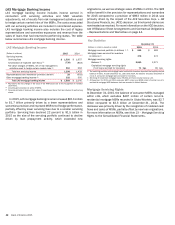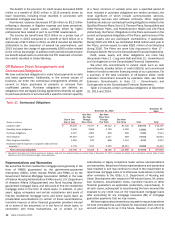Bank of America 2015 Annual Report Download - page 53
Download and view the complete annual report
Please find page 53 of the 2015 Bank of America annual report below. You can navigate through the pages in the report by either clicking on the pages listed below, or by using the keyword search tool below to find specific information within the annual report.Bank of America 2015 51
risk through consideration of potential actions that include asset
sales, business sales, capital or debt issuances, and other de-
risking strategies. We also maintain contingency plans as part of
our resolution plan to limit adverse systemic impacts that could
be associated with a potential resolution.
Strategic Risk Management
Strategic risk is embedded in every business and is one of the
major risk categories along with credit, market, liquidity,
compliance, operational and reputational risks. It is the risk that
results from incorrect assumptions, inappropriate business plans,
ineffective business strategy execution, or failure to respond in a
timely manner to changes in the regulatory, macroeconomic or
competitive environments, in the geographic locations in which we
operate, such as competitor actions, changing customer
preferences, product obsolescence and technology developments.
Our strategic plan is consistent with our risk appetite and
specifically addresses strategic risks.
The strategic plan is reviewed and approved annually by the
Board, as is the capital plan, financial operating plan and risk
appetite statement. With oversight by the Board, executive
management ensures that consistency is applied while executing
the Corporation’s strategic plan, core operating principles and risk
appetite. The executive management team continuously monitors
business performance throughout the year to assess strategic risk
and find early warning signals so that risks can be proactively
managed. Executive management regularly reviews performance
versus the plan, updates the Board via quarterly reporting routines
(and more frequently as relevant) and implements changes as
deemed appropriate. The following are assessed in the regular
executive reviews: forecasted earnings and returns on capital, the
current risk profile, current capital and liquidity requirements,
staffing levels and changes required to support the plan, stress
testing results, and other qualitative factors such as market growth
rates and peer analysis.
Significant strategic actions, such as capital actions, material
acquisitions or divestitures, and recovery and resolution plans are
reviewed and approved by the Board as required. At the business
level, as we introduce new products, we monitor their performance
relative to expectations (e.g., for earnings and returns on capital).
With oversight by the Board and the ERC, executive management
performs similar analyses throughout the year, and evaluates
changes to the financial forecast or the risk, capital or liquidity
positions as deemed appropriate to balance and optimize
achieving the targeted risk appetite, shareholder returns and
maintaining the targeted financial strength.
We use proprietary models to measure the capital requirements
for credit, country, market, operational and strategic risks. The
allocated capital assigned to each business is based on its unique
risk exposures. With oversight by the Board, executive
management assesses the risk-adjusted returns of each business
in approving strategic and financial operating plans. The
businesses use allocated capital to define business strategies,
and price products and transactions. For more information on how
this measure is calculated, see Supplemental Financial Data on
page 28.
Capital Management
The Corporation manages its capital position to maintain sufficient
capital to support its business activities and to maintain capital,
risk and risk appetite commensurate with one another. Additionally,
we seek to maintain safety and soundness at all times, even under
adverse scenarios, take advantage of organic growth
opportunities, maintain ready access to financial markets,
continue to serve as a credit intermediary, remain a source of
strength for our subsidiaries, and satisfy current and future
regulatory capital requirements. Capital management is integrated
into our risk and governance processes, as capital is a key
consideration in the development of our strategic plan, risk
appetite and risk limits.
We conduct an Internal Capital Adequacy Assessment Process
(ICAAP) on a periodic basis. The ICAAP is a forward-looking
assessment of our projected capital needs and resources,
incorporating earnings, balance sheet and risk forecasts under
baseline and adverse economic and market conditions. We utilize
periodic stress tests to assess the potential impacts to our
balance sheet, earnings, regulatory capital and liquidity under a
variety of stress scenarios. We perform qualitative risk
assessments to identify and assess material risks not fully
captured in our forecasts or stress tests. We assess the potential
capital impacts of proposed changes to regulatory capital
requirements. Management assesses ICAAP results and provides
documented quarterly assessments of the adequacy of our capital
guidelines and capital position to the Board or its committees.
The Corporation periodically reviews capital allocated to its
businesses and allocates capital annually during the strategic and
capital planning processes. For additional information, see
Business Segment Operations on page 30.
CCAR and Capital Planning
The Federal Reserve requires BHCs to submit a capital plan and
requests for capital actions on an annual basis, consistent with
the rules governing the CCAR capital plan.
In January 2015, we submitted our 2015 CCAR capital plan
and related supervisory stress tests. The requested capital
actions included a request to repurchase $4.0 billion of common
stock over five quarters beginning in the second quarter of 2015,
and to maintain the quarterly common stock dividend at the current
rate of $0.05 per share. On March 11, 2015, the Federal Reserve
advised that it did not object to our 2015 capital plan but gave a
conditional non-objection under which we were required to
resubmit our CCAR capital plan and address certain weaknesses
the Federal Reserve identified in our capital planning process. We
have established plans and taken actions which addressed the
identified weaknesses, and we resubmitted our CCAR capital plan
on September 30, 2015. The Federal Reserve announced on
December 10, 2015 that it did not object to our resubmitted CCAR
capital plan.
As of December 31, 2015, in connection with our 2015 CCAR
capital plan, we have repurchased approximately $2.4 billion of
common stock. The timing and amount of additional common stock
repurchases and common stock dividends will continue to be
consistent with our 2015 CCAR capital plan. In addition, the timing
and amount of common stock repurchases will be subject to
various factors, including the Corporation’s capital position,
liquidity, financial performance and alternative uses of capital,
stock trading price, and general market conditions, and may be
suspended at any time. The common stock repurchases may be
























